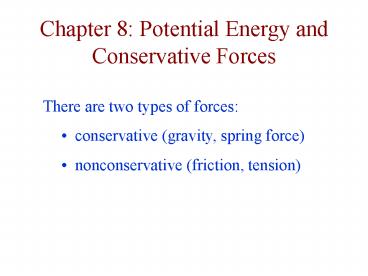Chapter 8: Potential Energy and Conservative Forces - PowerPoint PPT Presentation
1 / 19
Title:
Chapter 8: Potential Energy and Conservative Forces
Description:
If an object moves in a closed path (ri = rf) then total work done by the force is zero. ... A skateboard track has the form of a circular arc with a 4.00 m radius, ... – PowerPoint PPT presentation
Number of Views:745
Avg rating:3.0/5.0
Title: Chapter 8: Potential Energy and Conservative Forces
1
Chapter 8 Potential Energy and Conservative
Forces
- There are two types of forces
- conservative (gravity, spring force)
- nonconservative (friction, tension)
2
Conservative Forces
- A force is conservative if the work it does on an
object moving between two points is independent
of the path taken.
? work done depends only on ri and rf ? If an
object moves in a closed path (ri rf) then
total work done by the force is zero.
3
Nonconservative Forces
? work done by the force depends on the path ?
non-conservative forces dissipate energy
4
Conservative Nonconservative Forces
- The work done by gravity in moving from point 1
to point 2 is WG -mg(y2 y1). - Independent of path from point 1 to point 2.
- The work done by kinetic friction as an object
moves on a surface from point 1 to point 2 is Wf
-mk N (Path length). - Longer path results in greater work.
5
Potential Energy (Work Done by Conservative
Forces)
- Energy associated with the position of an object.
- For example When you lift a ball a distance y,
gravity does negative work on the ball. This
work can be recovered as kinetic energy if we let
the ball fall. The energy that was stored in
the ball is potential energy. - Wc DU
- Wc work done by a conservative force
- U potential energy
- The zero of potential energy is arbitrary. Only
the change in potential energy is relevant.
6
Gravitational Potential Energy
Gravitational potential energy
U mgy y height Work done by
gravity Wg DU Ui - Uf
7
Example
When a 4-kg object is moved from the ground to a
shelf 1 m high, what is the change in its
potential energy? If the object is dropped from
the shelf, what is the change in its potential
energy as it falls to the floor? What is its
change in kinetic energy as it falls to the
floor? What is the change in potential energy
if the same object is moved from the 1 m shelf to
a shelf 2 m high?
8
Spring Potential Energy
Uf Uf - Work done by spring on mass Mass m
starts at x0 (Ui 0) and moves until spring is
stretched to position x. WorkSpring - ½
kx2 U(x) 0 - (-1/2 kx2) U(x) ½ kx2
x displacement from equilibrium position
9
Walker, Problem 8, pg. 227
A vertical spring stores 0.962 J in spring
potential energy when a 3.0-kg mass is suspended
from it. (a) By what factor does the spring
potential energy change if the mass attached to
the spring is doubled? (b) Verify your answer to
part (a) by calculating the spring potential
energy when a 6.0-kg mass is attached to the
spring.
10
Conservation of Energy
- Energy is neither created nor destroyed
- The energy of an isolated system of objects
remains constant.
11
Mechanical Energy
- Mechanical energy E is the sum of the potential
and kinetic energies of an object. - E U K
- The total mechanical energy in any isolated
system of objects remains constant if the objects
interact only through conservative forces - E constant
- Ef Ei ? Uf Kf Ui Ki
12
Walker, Problem 19, pg. 228
A 5.00-kg rock is dropped and allowed to fall
freely. Find the initial kinetic energy, the
final kinetic energy, and the change in kinetic
energy for (a) the first two meters of fall and
(b) the second two meters of fall.
13
Pendulum
A 0.2-kg pendulum bob is swinging back and forth.
If the speed of the bob at its lowest point is
0.65 m/s, how high does the bob go above its
minimum height?
14
- Two billiard balls start rolling along a track at
the same time. Which one will win the race? - a. Ball 1
- b. Ball 2
- c. Its a tie.
1
2
15
Work Done by Nonconservative Forces
Nonconservative forces change the amount of
mechanical energy in a system. Wnc DE
Wnc work done by
nonconservative force Summary
of work formulae Wtotal DK Wtotal Wc
Wnc Wc DU Wnc DU DK Wnc DE
DK DU
16
Walker, Problem 30, pg. 239
A 1300-kg car drives up a 17.0-m hill. During
the drive, two nonconservative forces do work on
the car (i) the force of friction, and (ii) the
force generated by the cars engine. The work
done by friction is 3.31 ? 105 J the work done
by the engine is 6.34 ? 105 J. Find the change
in the cars kinetic energy from the bottom of
the hill to the top of the hill.
17
Walker, Problem 58, pg. 230
18
Walker, Problem 60, pg. 230
19
Walker, Problem 70, pg. 231
In the Figure, a 1.2-kg block is held at rest
against a spring with a force constant k 730
N/m. Initially, the spring is compressed a
distance d. When the block is released it slides
across a surface that is frictionless, except for
a section of width 5.0 cm that has a coefficient
of kinetic friction mk 0.44. Find d such that
the blocks speed after crossing the rough patch
is 2.3 m/s.































